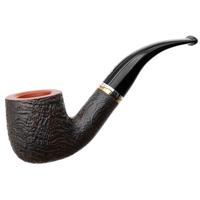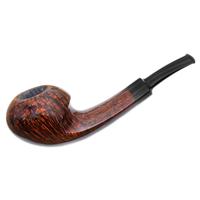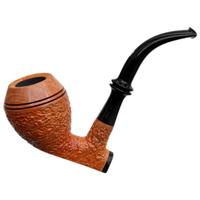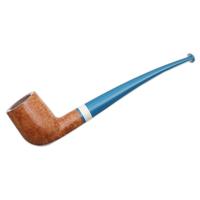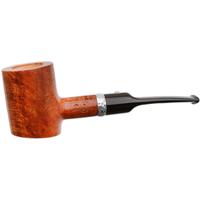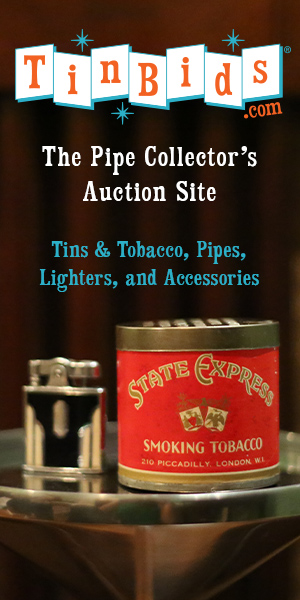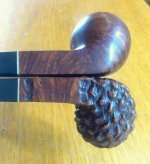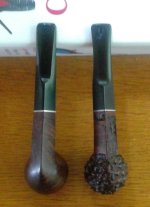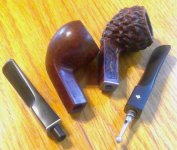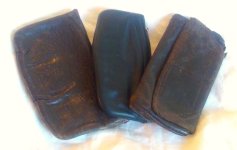Since I’m lucky enough to own two similar Kaywoodie bulldogs made about 60 years apart, I thought I’d post some pictures and write up a comparison of the two, in case anyone was wondering how the vintage models compare to the modern versions.
The rusticated bulldog is a Kaywoodie Natural Burl in shape number 12B. My dad bought it in the late 1950s and used it until he quit smoking in the 1970s. He gave it to me in the 1990s. Between the two of us it has around 50 years of smoking on it. This was one of dad’s “working pipes,” which means he would take it to work once or twice a week and smoke it all day. He did that for decades. I remember him loading up his well-worn leather pouch (it’s pictured below) in the evenings after dinner. Based on his and my usage, I estimate this pipe has probably seen around 10,000 bowls in its life.
The smooth bulldog is a 2019 Kaywoodie Standard with no shape stamp. I got it because I wanted a smooth version of dad’s old 12B to fill a seven spot pipe rack (at the time I only had six pipes). The pipe was fine as is, but to make it more closely match my dad’s older pipes, I stained it a bit more brownish, polished it up and added an aluminum spacer to simulate the stinger fitment. In the five years I’ve had it, the white paint in the stamped clover/club symbol has worn away and the rim has darkened a bit.
Dimensions: Both pipes have the same length (5 ¼”), bowl diameter (1 ½”), bowl height (1 ¾”) and shank diameter (½”). The chamber diameter is ¾” for both and the only variation I could find is that the newer pipe is 1/16” deeper than the 1950s version (1 & 7/16s” versus 1 & 3/8ths”). The difference between to two pipe’s weight was only five hundredths of an ounce; both weighed just a touch over an ounce.
Smoking impressions: I’ve smoked both back-to-back with a variety of tobaccos over the years and both pipes smoke very well and not surprisingly, very similarly. The older pipe has a stinger but air flow is similar, with the 2019 model’s airway a very slightly bit more open. The advertised “cooling effect” of the natural burl surface has no impact the older pipe’s smoking temperature to me. Dad didn’t think it did either, but thought it was a clever way for Kaywoodie to market lower-end briar. He did appreciate that the pipe had a good hand grip compared to smooth pipes. It looks a little like a WW2 pineapple hand grenade to me.
Conclusion: With virtually identical dimensions and weight these two pipes smoke, look and feel similar (excepting for the smooth vs. rusticated finish). It’s great that the Kaywoodie company has kept these traditional pipe shapes available and unchanged throughout the decades and the various family generational ownership changes. To me, the current version is a nice, no nonsense workingman’s pipe, just like the older version was intended to be. The cost was around $40 bucks if I recall correctly and for that I think it was a great deal for an attractively grained, traditional briar and vulcanite pipe. I’d like to thank Mr. Davis for being willing to take over the company and wish him the very best as the new owner of this true American icon.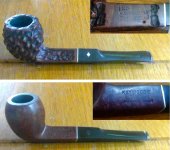
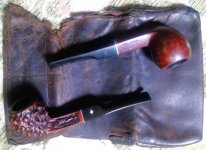
The rusticated bulldog is a Kaywoodie Natural Burl in shape number 12B. My dad bought it in the late 1950s and used it until he quit smoking in the 1970s. He gave it to me in the 1990s. Between the two of us it has around 50 years of smoking on it. This was one of dad’s “working pipes,” which means he would take it to work once or twice a week and smoke it all day. He did that for decades. I remember him loading up his well-worn leather pouch (it’s pictured below) in the evenings after dinner. Based on his and my usage, I estimate this pipe has probably seen around 10,000 bowls in its life.
The smooth bulldog is a 2019 Kaywoodie Standard with no shape stamp. I got it because I wanted a smooth version of dad’s old 12B to fill a seven spot pipe rack (at the time I only had six pipes). The pipe was fine as is, but to make it more closely match my dad’s older pipes, I stained it a bit more brownish, polished it up and added an aluminum spacer to simulate the stinger fitment. In the five years I’ve had it, the white paint in the stamped clover/club symbol has worn away and the rim has darkened a bit.
Dimensions: Both pipes have the same length (5 ¼”), bowl diameter (1 ½”), bowl height (1 ¾”) and shank diameter (½”). The chamber diameter is ¾” for both and the only variation I could find is that the newer pipe is 1/16” deeper than the 1950s version (1 & 7/16s” versus 1 & 3/8ths”). The difference between to two pipe’s weight was only five hundredths of an ounce; both weighed just a touch over an ounce.
Smoking impressions: I’ve smoked both back-to-back with a variety of tobaccos over the years and both pipes smoke very well and not surprisingly, very similarly. The older pipe has a stinger but air flow is similar, with the 2019 model’s airway a very slightly bit more open. The advertised “cooling effect” of the natural burl surface has no impact the older pipe’s smoking temperature to me. Dad didn’t think it did either, but thought it was a clever way for Kaywoodie to market lower-end briar. He did appreciate that the pipe had a good hand grip compared to smooth pipes. It looks a little like a WW2 pineapple hand grenade to me.
Conclusion: With virtually identical dimensions and weight these two pipes smoke, look and feel similar (excepting for the smooth vs. rusticated finish). It’s great that the Kaywoodie company has kept these traditional pipe shapes available and unchanged throughout the decades and the various family generational ownership changes. To me, the current version is a nice, no nonsense workingman’s pipe, just like the older version was intended to be. The cost was around $40 bucks if I recall correctly and for that I think it was a great deal for an attractively grained, traditional briar and vulcanite pipe. I’d like to thank Mr. Davis for being willing to take over the company and wish him the very best as the new owner of this true American icon.





